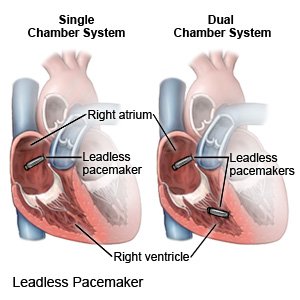Leadless Pacemaker
Medically reviewed by Drugs.com. Last updated on Apr 6, 2025.
What is a leadless pacemaker?
A leadless pacemaker is a small device that helps control a slow or irregular heartbeat. The device sends electrical impulses to your heart when needed. A leadless pacemaker uses battery power instead of a generator. This means it is not attached to wires. You may need a single-chamber or dual-chamber pacemaker. Single chamber means 1 device is placed in your right ventricle. Dual chamber means a second device is placed in your right atrium. The 2 devices of the dual-chamber system work together to regulate your heartbeat.
 |
How do I prepare for a pacemaker insertion?
- Your healthcare provider will tell you how to prepare for the procedure. Your provider may tell you not to eat or drink anything after midnight on the day of your procedure. Arrange to have someone drive you home after you leave the hospital.
- You may need a blood test, chest x-ray, or other tests to help your provider plan your procedure.
- Tell your provider about all your current medicines. Your provider will tell you if you need to stop any medicine for the procedure. Your provider will tell you which medicines to take or not take on the day of your procedure.
- You may be given an antibiotic to prevent infection. Tell your provider if you have ever had an allergic reaction to an antibiotic.
Drugs used to treat this and similar conditions
Isuprel
Isuprel is used for adams-stokes syndrome, AV Heart Block, bronchospasm during anesthesia, cardiac ...
Lasix
Lasix is a loop diuretic used to treat fluid retention from heart, liver, or kidney conditions, and ...
Omvoh
Omvoh is used to treat moderate to severe ulcerative colitis or Crohn's disease in adults. This ...
Adrenalin
Adrenalin is used for adams-stokes syndrome, allergic reactions, anaphylaxis, asthma, acute ...
Betapace
Betapace and Betapace AF tablets are antiarrhythmic drugs used in the treatment of ventricular ...
Spironolactone
Spironolactone is a potassium-sparing diuretic that is primarily used to treat heart failure, high ...
Calcium chloride
Calcium chloride systemic is used for asystole, electromechanical dissociation, hyperkalemia ...
Propranolol
Propranolol is a beta-blocker that is used to treat tremors, chest pain, high blood pressure, heart ...
Vasopressin
Vasopressin systemic is used for abdominal distension prior to abdominal x-ray, abdominal ...
Hydrochlorothiazide
HCTZ (hydrochlorothiazide) used to treat high blood pressure (hypertension) and edema. Includes ...
What will happen during a pacemaker insertion?
- You may be given IV sedation to make you feel calm and relaxed during the procedure. You may also be given local anesthesia to numb the catheter site. With local anesthesia, you may still feel pressure or pushing, but you should not feel pain.
- Your healthcare provider will insert a needle into a vein in your groin. A catheter (thin tube) will be inserted into the vein and guided into position. The pacemaker will be secured to the right ventricle. A second device may be placed in the right atrium. Your provider will check for correct device placement and function. Then the catheter will be removed.
- Your incisions will be closed with stitches, medical glue, or medical tape. They will be covered with a bandage to prevent an infection.
What should I expect after a pacemaker insertion?
- You will need to lie flat with your leg straight for a few hours. This helps prevent bleeding from the catheter site.
- Healthcare providers will monitor your heartbeat.
- You may have bruising or pain near your incision. These should get better in a few days.
- You may need to spend a night in the hospital.
What are the risks of a leadless pacemaker insertion?
The catheter site may bleed more than expected or develop an infection. The pacemaker could move out of place and need to be placed again. A displaced pacemaker can cause an irregular heartbeat, heart failure, blood clots, or other problems. You may develop valve regurgitation. This means the valve between the right ventricle and right atrium does not close as it should. Blood then leaks back into the atrium. Rarely, cardiac bleeding may happen and need to be stopped with surgery. These problems may become life-threatening.
Care Agreement
You have the right to help plan your care. Learn about your health condition and how it may be treated. Discuss treatment options with your healthcare providers to decide what care you want to receive. You always have the right to refuse treatment. The above information is an educational aid only. It is not intended as medical advice for individual conditions or treatments. Talk to your doctor, nurse or pharmacist before following any medical regimen to see if it is safe and effective for you.© Copyright Merative 2025 Information is for End User's use only and may not be sold, redistributed or otherwise used for commercial purposes.
Further information
Always consult your healthcare provider to ensure the information displayed on this page applies to your personal circumstances.
